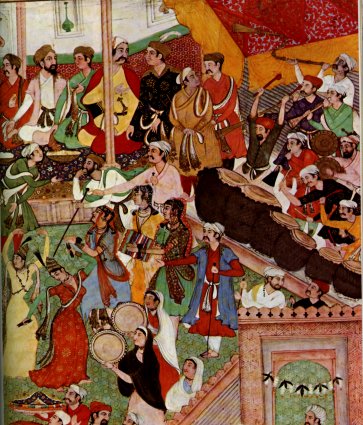Middle Eastern Drum History
The modern goblet-shaped doumbek/darabuka/zarb has probably been a
popular instrument in the Middle East for less than a century.
Historic evidence such as artistic representations and accounts tend
to favor the frame drum and riq/tamborine as the chief ensemble
percussion instrument for much of recorded history in the Middle East.
The following three pictures are very representative of how the music
ensemble is protrayed in art of 13th through the 17th centuries. They
generally show a small group consisting of a couple of melody
instruments -- such as a ney(flute), oud, harp, etc, and one or two
frame drums possibly with cymbals (riq). There are many examples of
similar pictures. This first is from 1524-25 (Khamseh (Quintet) by
Nizami) and the second from a manuscript dated 1524-76.
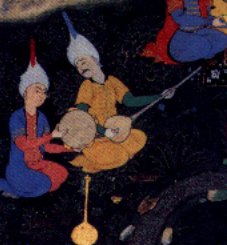

Here is an earlier picture from 13th century Persia:

In the 19th century the goblet shaped drum begins to appear
prominently in the artistic record. Here is a picture from the Qajar
period in Persia.

There is some evidence for the goblet-shaped drum earlier, however.
Here is a picture from the "Cantigas de Santa Maria" (Alfonso X "El
Sabio" (1221-1284)). The text describes a Jewish couple. Clearly the
woman is playing a drum. It is probably one similar to modern
Moroccan drums that are an elongated version of the darabuka
(goblet-shaped) drum. Note that her posture is very similar to how
someone would play a frame drum.

There is a color (and better quality) version of this picture here.
I suspect that the modern classical Arabic tabla technique --
under-the-arm, one hand dominant -- is a direct descendant of frame
drum technique. Classical frame drum technique relies heavily on the
dominant hand (the one not always holding the drum) -- the second hand
uses only a couple of fingers to add fill. If you just turn your
hands over and point your fingers down instead of up, you approximate
the basic modern tabla/darabuka technique.
Here is a picture of an ewer from "Classical Persian Music" (Ella
Zonis, 1973).

The caption reads: "A brass ewer from the thirteenth century
showing players of the drum, tambourine, and flute." I presume
the artifact is Persian, although I'm not sure. It is interesting
because it shows stylized pictures of players of percussion
instruments. Notably the daf (frame drum) that is found in many
similar works as we've seen:

But also notice the another drum held in what is probably a posture
similar to the modern under-the-arm method employed in playing the
darabuka. Note the detail just above the drum, which I presume, is
the players other hand:

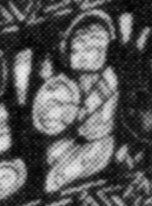
Additionally note the following picture with the floppy-sleeved
dancer. Is the nearby musician playing a two-ended drum similar to
modern Indian/Rajistani drums? Or is it someone playing a goblet-style
drum that has tilted downward?

And what is it that the person on the left is holding in this part of
the design? Is it a harp or a two-ended or a goblet-shaped drum?

Here are a couple of excerpts from Persian pictures from 1519 and 1590 that
clearly show goblet style drums being played (by Persian gypsies) in
the under-the-arm method. This is the clearest example I know of
period use of this drum -- it's unfortunate there are not more
examples.

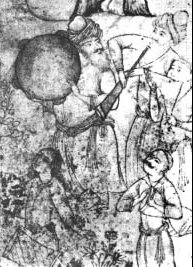
Check out Peyman's webpage for more information on the occurance of drums in Persian art as well as Persian percussion in general:
http://nasehpour.tripod.com/peyman/id12.html
Other types of drums were used in military music, louder folk-music and ensembles with horns and loud reed instruments.
Here is a picture from Maqaamaat by Hariirii, painted in Baghdad in
1237 that shows large kettle drums carried on camels. The caption in
"The World of Islam" (Bernard Lewis, 1976) says that they are
naqqaaraat -- a paired set of kettle drums. However, to me it appears
that there are two drummers in the picture each playing a single
drum.
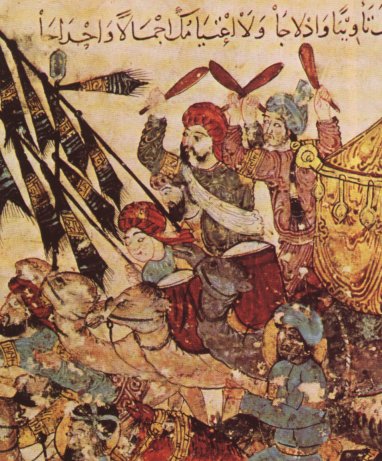
These larger (and louder) drums were used in military music and other
loud and outdoor settings. Here is a picture from 1592 of a Turkish
military band.

Note the davul (tabla beledi) players -- using the bent ended striker that is
still used today:
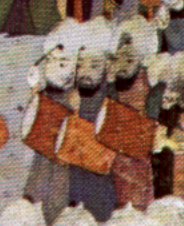
Here is picture (al_Jazarii, Automata) that illustrates a waterclock
from the early 14th c. and shows both a kettle or bowl-style drum as
well as a davul-like instrument. Is the davul player using his left
hand to strike the drum or is there something in/on his hand? (Some
players in parts of Persia today play a davul style drum with their
hands rather than sticks -- similar to the Indian Dholak.)

Here is a picture from 16th century Islamic India that shows frame
drums, naqqaaraat, and what I think is a double-ended hand drum
(dholak?), being played in a large dance and music ensemble with
various loud melody and other percussion instruments.
